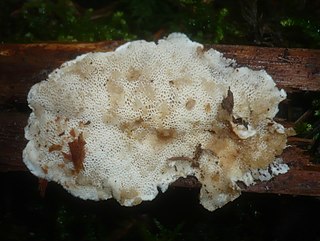
The Tremellomycetes are a class of dimorphic fungi in the Agaricomycotina. Some species have gelatinous basidiocarps or (microscopically) a sacculate parenthesome. There are six orders, 17 families, and 39 genera in the Tremellomycetes. Tremellomycetes include yeasts, dimorphic taxa, and species that form complex fruiting bodies. Tremellomycetes include some fungi that are human and animal pathogens in the genera Cryptococcus, Naganishia, Papiliotrema, and Trichosporon and some fungi that are cultivated for food in the genera Tremella and Naematelia.
The Cystofilobasidiales are an order of fungi in the class Tremellomycetes of the Basidiomycota. They usually exhibit a life phase of free-living yeasts. The order contains two families with seven genera and some 25 species.
The Filobasidiales are an order in the fungal class Tremellomycetes. The order contains two families and seven genera.

The Tremellales are an order of fungi in the class Tremellomycetes. The order contains both teleomorphic and anamorphic species, most of the latter being yeasts. All teleomorphic species in the Tremellales are parasites of other fungi, though the yeast states are widespread and not restricted to hosts. Basidiocarps, when produced, are gelatinous.
The Cuniculitremaceae are a family of fungi in the order Tremellales. There are three genera in the family. Sterigmatosporidium polymorphum parasitizes other fungi growing in insect galleries in wood. It does not produce basidiocarps, but has septate basidia similar to those found in the genus Tremella. Most species are known only from their yeast states.
The Cystofilobasidiaceae are a family of fungi in the order Cystofilobasidiales. Phylogenetic analyses shows that this family is clearly distinct from other yeast-like families of the Tremellomycetes. The family currently contains the single genus Cystofilobasidium. Additional genera previously referred to the Cystofilobasidiaceae are now placed in the Mrakiaceae.
The Filobasidiaceae are a family of fungi in the order Filobasidiales. Most species are yeasts, but some form gelatinous fruit bodies that are parasitic on other fungi, including lichens. The family currently contains five genera.
The Mrakiaceae are a family of fungi in the order Cystofilobasidiales. Phylogenetic analyses shows that this family is clearly distinct from other yeast-like families of the Tremellomycetes. The family had six genera in 2015.
Cystofilobasidium is a genus of fungi in the family Cystofilobasidiaceae. Species occur as yeasts, but produce filamentous sexual states that form dikaryote teliospores, from which the unicellular basidia are formed. The hyphae usually have dolipore septa without a parenthesome, and their cell walls contain xylose. The genus currently contains nine species worldwide.
The Holtermanniales are an order in the fungal class Tremellomycetes. The order contains two genera. Species of Holtermannia produce groups of horn-like gelatinous basidiocarps on wood and have associated yeast states. Species of Holtermaniella are only known as yeasts.
The Naemateliaceae are a family of fungi in the order Tremellales. The family currently contains two genera.
The Phaeotremellaceae are a family of fungi in the order Tremellales. The family currently contains two genera.
The Cryptococcaceae are a family of fungi in the order Tremellales. The family currently contains two genera. Some species produce filamentous, sexual states with distinctive basidia and are parasites of other fungi. Most, however, are only known from their yeast states. Several species of Cryptococcus are human pathogens.
The Bulleraceae are a family of fungi in the order Tremellales. The family currently contains five genera. Some species produce gelatinous basidiocarps and were formerly placed in the genus Tremella. Most, however, are only known from their yeast states.
The Bulleribasidiaceae is a family of fungi in the order Tremellales.
The Rhynchogastremaceae are a family of fungi in the order Tremellales. The family currently contains two genera. Some species produce filamentous sexual states with septate basidia and are parasites of other fungi. Most, however, are only known from their yeast states.
The Trimorphomycetaceae are a family of fungi in the order Tremellales. The family currently contains four genera. Some species produce filamentous sexual states and are parasites of other fungi. Most, however, are only known from their yeast states.
The Trichosporonaceae are a family of fungi in the order Trichosporonales. The family currently contains six genera. Species are not known to produce basidiocarps, but exist as yeasts or produce septate hyphae with arthroconidia. Several species are human pathogens.
The Tetragoniomycetaceae are a family of fungi in the order Trichosporonales. The family currently contains four genera. Several species are only known from their yeast states.

The Carcinomycetaceae are a family of fungi in the order Tremellales. The family currently contains a single genus. Some species produce filamentous sexual states with basidia and are parasites of other fungi. Some, however, are only known from their yeast states.


